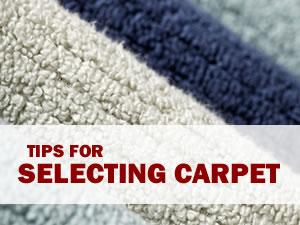As carpet care professionals, we are frequently asked about different types of carpeting – what are the different types and which are best for specific environments, etc. So, we’ve gathered some information for you. Keep it handy and refer to it when you’re shopping for new carpeting.
The number of choices out there may seem pretty overwhelming when you’re looking to buy or replace your carpeting. We’re here to help you narrow things down a bit.
There are basically four things to decide up front:
- Where will this carpeting be installed? This can be broken into a few sub-questions: is it formal or informal? Private or public? High or low traffic?
- How do you want the carpet to feel?
- What’s your budget?
- How much effort do you want to put in to maintain it?
Ok, so you’ve answered these questions, you are ready to make the best choices for your needs.
True, if you’re looking at all the patterns and colors and designs available, but we’ll let you in on a little secret… It’s all basically variations on three styles: loop pile, cut pile and cut and loop.
Loop Pile
This is more commonly known as Berber. Loop pile is often the preference for commercial or high usage areas. It’s easier to maintain, slower to show wear and a good choice when wheelchair or walker traffic is likely. Of course, if you want that soft, run-through-it-barefoot feeling, you probably won’t like loop pile much.
Cut Pile
When you know that all carpet starts out as loop pile, the term cut begins to make a bit more sense – all the loops are cut so they stand alone. This is the go-to category for those looking for something softer underfoot.
Low and dense. The most durable in the cut pile family is a low and dense cut pile, that’s possibly not much more comfortable than Berber due to the lack of depth in the pile – the very thing that makes it more durable and easier to keep clean. It holds up well in high use, regular traffic areas, like playrooms, rec rooms, offices and the like.
Deep plush. Never fear, bare-footers – there’s deep, luxurious plush as well. Just don’t expect it to stay clean as long. It can more easily become matted down as well. Oh, and this decadent deep plush has one more drawback. It shows footprints and vacuum tracks like crazy. It sure is nice to the toes, though. This deep cut pile is most suited to lower use areas, such as formal sitting rooms, master bedrooms, and private studies.
Plush with a twist. Somewhere along the line someone got clever and invented “trackless” carpet. A slight variation on the deep plush, where the individual fibers are either cut at differing heights or twisted and crimped, resulting in different reflectivity of light that makes tracks virtually invisible. This “textured plush” will show less wear than most other styles and is easy to maintain.
Cut and Loop Pile
Pretty much just what it sounds like – a combination of high cut pile and low loops. This offers many design possibilities from straight lines to geometric patterns to floral or other more intricate designs. This style of pile is easy to maintain and keep clean and holds up well in high traffic areas, and can certainly be less boring than its low and dense cut pile cousin.
That’s your basic rundown on styles. Know what your carpet will be subjected to and research your specific brands. Carefully matching your selection to the conditions it will have to weather will help avoid disappointments down the line.
Now, let’s talk materials…
Though you may find some blends, most carpets today are made solely of either polypropylene (olefin falls in this category), polyester, or nylon. As far as natural fibers go, wool is currently popular, but tends to fall outside of most folks’ budgets and/or care needs. Synthetic carpets are much more stain resistant. Olefin and polyester being naturally stain resistant, while nylon requires a treatment in order to resist stains. Olefin tends to give you the best bang for your buck, followed by polyester and then nylon.
A Note On Price: The order presented is merely a guideline. Don’t make the mistake of assuming that a higher price tag means higher quality. This may not be the case, since certain manufacturers are better with some materials than others.
A Note On Cleaning and Warranties: Review the details of the manufacturers’ warranty on whatever carpets you are considering. We know everyone hates the fine print, but this could really save your, uh, shag somewhere down the road. Manufacturers often have specific care requirements that must be met to keep from voiding the warranty. Voiding the warranty really isn’t something you want to do, so this is good to know. It will also give you a good idea if your selection is going to be as “low maintenance” as you think it is.
Finally, about carpet pads: A lot of people think the thicker the pad, the better, particularly if you don’t find the carpet as soft as you were hoping. But this is not the case. Most Berber rugs, for example, should have a flat carpet pad, while many plush carpets actually need thicker ones.
We hope these pointers will be helpful in finding the carpet you not only love, but will fit your specific needs. And once you have them, we look forward to helping you keep them looking great.
This is one of a series of articles written and published on behalf of Stone and Tile PRO Partners.

